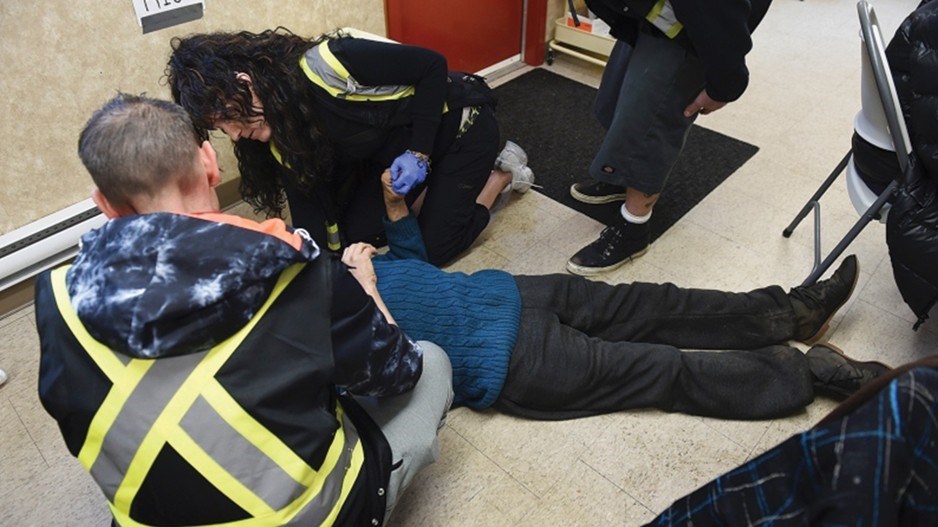Some 176 British Columbians died of illicit drug overdoses in April, bringing 2021’s death toll so far to 680 people.
The month is the most fatal for such deaths since the opioid crisis began.
April marks the twentieth consecutive month where more than 100 people have died, or 5.9 people per day. The death toll is a 43% increase over the number of deaths reported in April 2020 and a 10% increase over the 160 deaths in March.
Last year was the worst year for illicit drug deaths, with 1,726 deaths. The highest number previously was in 2018, with 1,549 deaths. By April 2018, 535 people died, down from 555 in April of 2017, a year which saw 1,493 fatalities.
"Once again, we're reminded that the scale of this public health emergency is truly unprecedented," said B.C. chief coroner Lisa Lapointe. "I offer my heartfelt condolences to every family in the province that is experiencing the unimaginable pain of sudden and unexpected loss.
“Every life lost to toxic drugs in our province is a profound tragedy. Every one of them mattered, and every one of them will be missed.”
Minister of Mental Health and Addictions Sheila Malcolmson said the new figures show the situation is not improving.
“This is devastating for so many people grieving the loss of their loved ones,” she said. “It is hard to fathom that despite the incredible efforts of front-line workers, health and community organizations, and all those working tirelessly to save lives, we continue losing friends and family to toxic street drugs. It is unacceptable.”
Malcolmson said the collision of the overdose crisis and COVID-19 pandemic hurt progress being made.
"Our government will continue expanding life-saving resources across the continuum of care, from safer supply to more treatment beds,” Malcolmson said.
“Going forward, we are deepening our investment in people and all-hands-on-deck interventions."
B.C. Green Party Leader Sonia Furstenau said it’s time for all parties to work collaboratively as with the pandemic to fight the opioid crisis.
“We saw this a year ago, when in response to the COVID-19 pandemic, $5 billion was unanimously approved for emergency spending,” Furstenau said. “It has been five years since this illicit drug toxicity emergency was declared and in that time, we have not seen a similar all-party approach that treats this emergency for what it is.”
The Green leader has called on the NDP to allocate part of the government’s $3.1 billion dollar contingency fund towards a regulated and expanded safe drug supply and to implement an all-party committee to create meaningful long term solutions to the toxicity crisis.
Further, said Green MLA Adam Olsen, Indigenous people accounted for 15% of all illicit drug deaths in 2020, five times more than their share of B.C.’s total population.
“These drug poisonings are another part of the legacy of trauma that Indigenous people have endured over generations,” Olsen said. “As we speak of reconciliation in this country, and in this Legislative Assembly, we must include urgent supports for those managing the devastating impacts of intergenerational trauma.”
Fraser and Vancouver Coastal health authorities accounted for 61% of suspected illicit drug toxicity deaths in British Columbia in 2021.
And, B.C.’s drug supply toxicity has continued to increase.
Fentanyl has been detected in 86% of 2021 deaths, while carfentanil, a more potent fentanyl analogue, has been found in 62 samples in 2021, almost as many as the 65 detected in 2020.
Reporting notes a continued increase in the presence of benzodiazepines, detected in 57% of samples in April, almost four times the 15% reported in July 2020.
"These latest numbers emphasize the toxicity of the illicit drug supply in B.C.," Lapointe said. "We know that substance use disorder is a complex health issue, and those experiencing it need meaningful and compassionate services and supports.
“Far too often, we hear from families who have lost a loved one that no help was available despite desperate searches over months or years. It is critical that harm reduction services, including safe supply, are accessible where and when people need them, and that recovery services are evidence based and accountable."
Among other coroners service findings for April are:
• Males accounted for 79% of deaths in 2021;
• In 2021, 70% of those dying were aged 30 to 59;
• The proportion of deaths of those 50 years of age and older has steadily increased over the past six years. In 2021, 39% of deaths have been 50 years or over; and
• No deaths have been reported at supervised consumption or drug overdose prevention sites.
[email protected]
twitter.com/jhainswo



